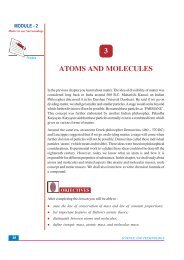Audio and Video programmes - The National Institute of Open ...
Audio and Video programmes - The National Institute of Open ...
Audio and Video programmes - The National Institute of Open ...
Create successful ePaper yourself
Turn your PDF publications into a flip-book with our unique Google optimized e-Paper software.
Prog. Duration in Minutes<br />
Code Title <strong>of</strong> Programmes Language in Hindi in English<br />
212/V-17 Human Reproduction Hindi <strong>and</strong> English 12.53 13.50<br />
This programme emphasises that all organisms must reproduce for maintenance <strong>of</strong> their species. Various<br />
parts <strong>of</strong> the male <strong>and</strong> the female reproductive system have been described in the programme. <strong>The</strong> processes<br />
<strong>of</strong> formation <strong>and</strong> production <strong>of</strong> the ovum have been shown in relation to the menstrual cycle in females. <strong>The</strong><br />
programme also shows various steps in fertilization, development <strong>and</strong> growth <strong>of</strong> the foetus. A special<br />
depiction has been made in the programme mentioning the basis <strong>of</strong> the determination <strong>of</strong> sex <strong>of</strong> the child.<br />
Towards the end, several aspects <strong>of</strong> a pregnant mother have been shown with regard to proper environment<br />
<strong>and</strong> nourishment etc. It suggests the right age group <strong>of</strong> females for having children <strong>and</strong> the importance <strong>of</strong><br />
family planning <strong>and</strong> methods for achieving the same.<br />
212/V-18 Skeleton Muscles <strong>and</strong> Movement Hindi <strong>and</strong> English 12.20 11.00<br />
This programme highlights the need <strong>of</strong> the locomotary system in the animal world by showing different<br />
animals, each one in an active phase <strong>of</strong> movement either for food or for protection against enemies. <strong>The</strong><br />
second part <strong>of</strong> the programme explains the need <strong>of</strong> the skeleton to give shape to the body <strong>and</strong> to provide<br />
attachment to muscles. <strong>The</strong> programme also brings out the differences between bone <strong>and</strong> cartilage <strong>and</strong><br />
explains various kinds <strong>of</strong> joints <strong>and</strong> muscles, <strong>and</strong> shows the working <strong>of</strong> these muscles in movement <strong>and</strong> in<br />
various postures. <strong>The</strong> need <strong>of</strong> maintaining proper posture during various activities has also been highlighted.<br />
212/V-19 Agricultural Practices Hindi <strong>and</strong> English 12.12 12.30<br />
This programme throws light on those scientific <strong>and</strong> agricultural practices which are necessary to increase<br />
our food production. Various methods <strong>and</strong> techniques to increase production have also been explained<br />
<strong>and</strong> each part <strong>of</strong> those methods has been highlighted. Towards the end, the programme emphasizes that<br />
scientific <strong>and</strong> agricultural practices are the only means for achieving success in better food production.<br />
212/V-20 Animal Husb<strong>and</strong>ry Hindi <strong>and</strong> English 12.08 12.30<br />
This programme focuses on the uses <strong>of</strong> animals <strong>and</strong> their classification. <strong>The</strong> programme shows different<br />
types <strong>of</strong> sheds for different types <strong>of</strong> animals which protect them from heat, cold, rain etc. This programme<br />
also shows prevention <strong>of</strong> various diseases like viral, bacterial <strong>and</strong> fungal diseases.<br />
212/V-21 Wonders <strong>of</strong> Radio Activity Hindi <strong>and</strong> English 13.47 13.40<br />
This programme begins with elucidation <strong>of</strong> the phenomenon <strong>of</strong> radioactivity in its entirety. <strong>The</strong> programme<br />
demonstrates the uses <strong>of</strong> radioactivity in various areas such as medicine, archaeology <strong>and</strong> other basic <strong>and</strong><br />
applied sciences. <strong>The</strong> programme also highlights the pioneering contributions made by scientists like<br />
Henry Becquerel, who discovered radioactivity; <strong>and</strong> Nobel Prize winner Madam Curie in the field <strong>of</strong><br />
radioactivity.<br />
26

















